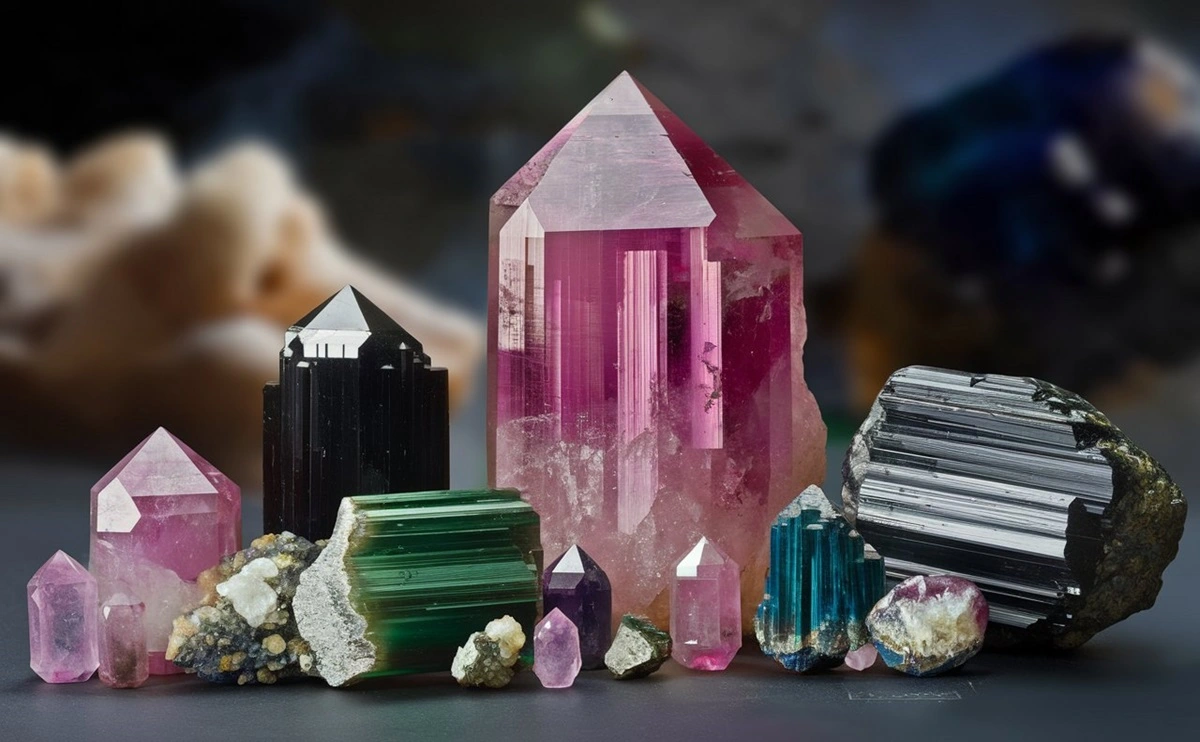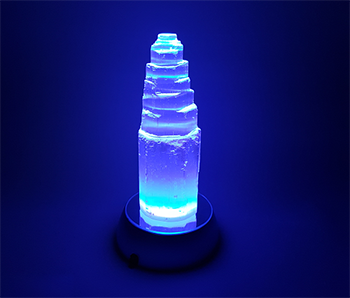Tourmaline is one of the most vibrant and diverse gemstones found in nature. Known for its wide array of colors and remarkable properties, tourmaline is cherished by both mineral collectors and gemstone collectors alike. This semiprecious gemstone is a favorite in jewelry, lapidary arts, and scientific studies due to its unique chemical composition and intriguing optical effects.
Table of content – Jump to
What is Tourmaline?
Tourmaline’s Physical and Optical Properties
Formation and Occurrence
Tourmaline in Gemology and Jewelry
Frequently Asked Questions (FAQ)
Conclusion
What is Tourmaline?
Tourmaline is a boron silicate mineral with a complex chemical formula that can vary depending on its composition. It crystallizes in the trigonal crystal system, forming colorful crystals that often exhibit transparent to translucent qualities. Tourmaline occurs in a variety of geological environments, including granitic pegmatites and metamorphic rock formations.
Varieties of Tourmaline
Tourmaline exists in numerous varieties, each distinguished by its color and composition. Some of the most notable types include:
- Elbaite – One of the most sought-after and colorful varieties, often found in gem-quality specimens.
- Dravite – Typically brown to yellowish-brown, commonly found in metamorphic rock.
- Liddicoatite – A rare variety known for striking color zoning and complex growth patterns.
- Chromedravite – A green variety rich in chromium.
- Paraíba Tourmaline – A rare and highly prized neon blue-to-green variety originating from Minas Gerais, Brazil.
- Rubellite – A vivid pink-to-red variety prized for its beauty and transparency.
- Pink tourmaline, green tourmaline, and blue tourmaline – Popular choices in semiprecious gemstone jewelry
Tourmaline’s Physical and Optical Properties
Tourmaline exhibits several fascinating physical and optical properties:
- Hardness: 7–7.5 on the Mohs hardness scale, making it durable for jewelry use.
- Refractive Index: Ranges from 1.614 to 1.666.
- Birefringence: Moderate to strong, often displaying distinct color variations.
- Specific Gravity: Typically 3.06 to 3.10.
- Pleochroism: Strong in many varieties, meaning the color changes when viewed from different angles.
- Chatoyancy (Cat’s-Eye Effect): Some specimens display this optical phenomenon.
- Color Zoning: Many tourmaline crystals exhibit zones of varying colors within the same specimen.
- Transparency: High-quality transparent crystals are highly valued in the gemstone market.
Formation and Occurrence
Tourmaline forms primarily in granitic pegmatites, where the slow cooling of magma allows for the growth of large, well-formed crystals. These pegmatites provide the necessary elements, such as boron, aluminum, and iron, that contribute to the diverse coloration of tourmaline. The presence of different trace elements during crystallization determines the final hue of the mineral.
In addition to pegmatites, tourmaline is also found in metamorphic rock environments. Metamorphic processes, such as high-pressure and high-temperature conditions, cause the recrystallization of pre-existing minerals, leading to the formation of tourmaline in schists and marbles. These metamorphic rocks often contain iron-rich varieties like dravite.
Tourmaline is widely distributed across the globe, with some of the most significant deposits found in Minas Gerais, Brazil. This region is particularly famous for its production of gem-quality Paraíba tourmaline, known for its striking neon blue-green hues. Other notable locations include Afghanistan, Madagascar, Nigeria, Mozambique, and Sri Lanka, which produce a variety of colors and high-quality specimens.
The United States also boasts important sources of tourmaline, particularly in California and Maine. California’s pegmatite deposits have yielded impressive elbaite crystals in shades of pink and green, while Maine’s discoveries have been valued for their exceptional clarity and unique color zoning.
Some of the world’s most stunning tourmaline specimens can be seen in museum collections, including those housed at the Natural History Museum of Utah. These displays showcase the incredible diversity of tourmaline’s crystal forms, colors, and mineral associations, providing valuable insights into its geological formation and occurrence.

Tourmaline in Gemology and Jewelry
Tourmaline is a popular choice for faceting and carving, thanks to its hardness and striking colors. High-quality transparent crystals are cut into gemstones, while lower-grade material is used for decorative objects and sculptures.
As an October birthstone, tourmaline is widely used in semiprecious gemstone jewelry, including rings, pendants, earrings, and bracelets. The Gemological Institute of America provides certifications and research on tourmaline’s gemological characteristics.
Enhancements and Treatments
To enhance its color and clarity, tourmaline may undergo various treatments:
- Heat Treatment: Used to intensify or change color.
- Irradiation: Commonly applied to pink and red tourmalines to enhance vibrancy.
- Fracture Filling: Improves clarity by filling cracks with resin or glass.
Unique Electrical Properties
Tourmaline is known for its unique electrical properties, making it useful in scientific applications:
- Pyroelectricity: When heated, tourmaline generates an electrical charge.
- Piezoelectricity: The crystal produces electricity when subjected to mechanical stress.
Inclusions and Crystallography
Tourmaline often contains distinctive inclusions, such as trichites, three-phase inclusions, and growth tubes, which help gemologists distinguish natural stones from synthetic counterparts. Crystallography studies have revealed the complex internal structures of tourmaline, making it an exciting subject in mineralogy.
Tourmaline in the Market
Tourmaline is a favorite among gem traders and jewelry designers. Some of the most expensive varieties, such as Paraíba tourmaline, can fetch extremely high prices due to their rarity and intense colors. The demand for colorful crystals and unique gem-quality specimens continues to grow in the international market.

Frequently Asked Questions (FAQ)
1. What gives tourmaline its wide range of colors?
Tourmaline’s diverse color palette is due to trace elements such as iron, manganese, lithium, and chromium. Different chemical compositions result in a broad spectrum of hues.
2. How can I tell if a tourmaline gemstone is natural?
Authentic tourmalines often exhibit pleochroism, meaning they change color when viewed from different angles. Natural specimens may also contain inclusions such as three-phase inclusions or trichites, visible under magnification.
3. What is the rarest variety of tourmaline?
Paraíba tourmaline, known for its neon blue-green color, is among the rarest and most valuable varieties.
4. How should I care for my tourmaline jewelry?
Tourmaline is relatively hard but can still be scratched or damaged by sharp blows. Clean it with mild soap, warm water, and a soft brush. Avoid ultrasonic cleaners and extreme temperature changes.
5. Can tourmaline be synthetically created?
While synthetic tourmaline is rare, some treated or enhanced stones exist in the market. Always purchase from reputable dealers to ensure authenticity.
6. Why does tourmaline have such strong pleochroism?
The strong pleochroism in tourmaline is due to its complex crystal structure and varying absorption of light along different crystallographic axes.
7. Is tourmaline a good investment?
High-quality tourmalines, especially rare varieties like Paraíba tourmaline, can be excellent investments. Their value appreciates over time due to their rarity and demand in the jewelry market.
For further exploration into the fascinating world of tourmaline, consider these reputable sources:
- Gemological Institute of America – Tourmaline Guide
- Mindat – Tourmaline Mineral Data
- Minerals.net – Tourmaline Overview
Conclusion
Tourmaline is an extraordinary gemstone with a vast spectrum of colors and intriguing physical properties. Whether admired by mineral collectors, fashioned into fine jewelry, or studied in laboratories like Earth Lab, its versatility and beauty make it a cherished mineral worldwide. Whether you’re drawn to the striking blue of Paraíba tourmaline, the deep red of rubellite, or the unique color zoning of liddicoatite, tourmaline continues to captivate and inspire.
If you’re looking to add a stunning piece of gem-quality tourmaline to your collection, be sure to explore reputable sources and certified dealers. With its rich history and remarkable characteristics, tourmaline is truly one of nature’s most captivating colorful crystals!


